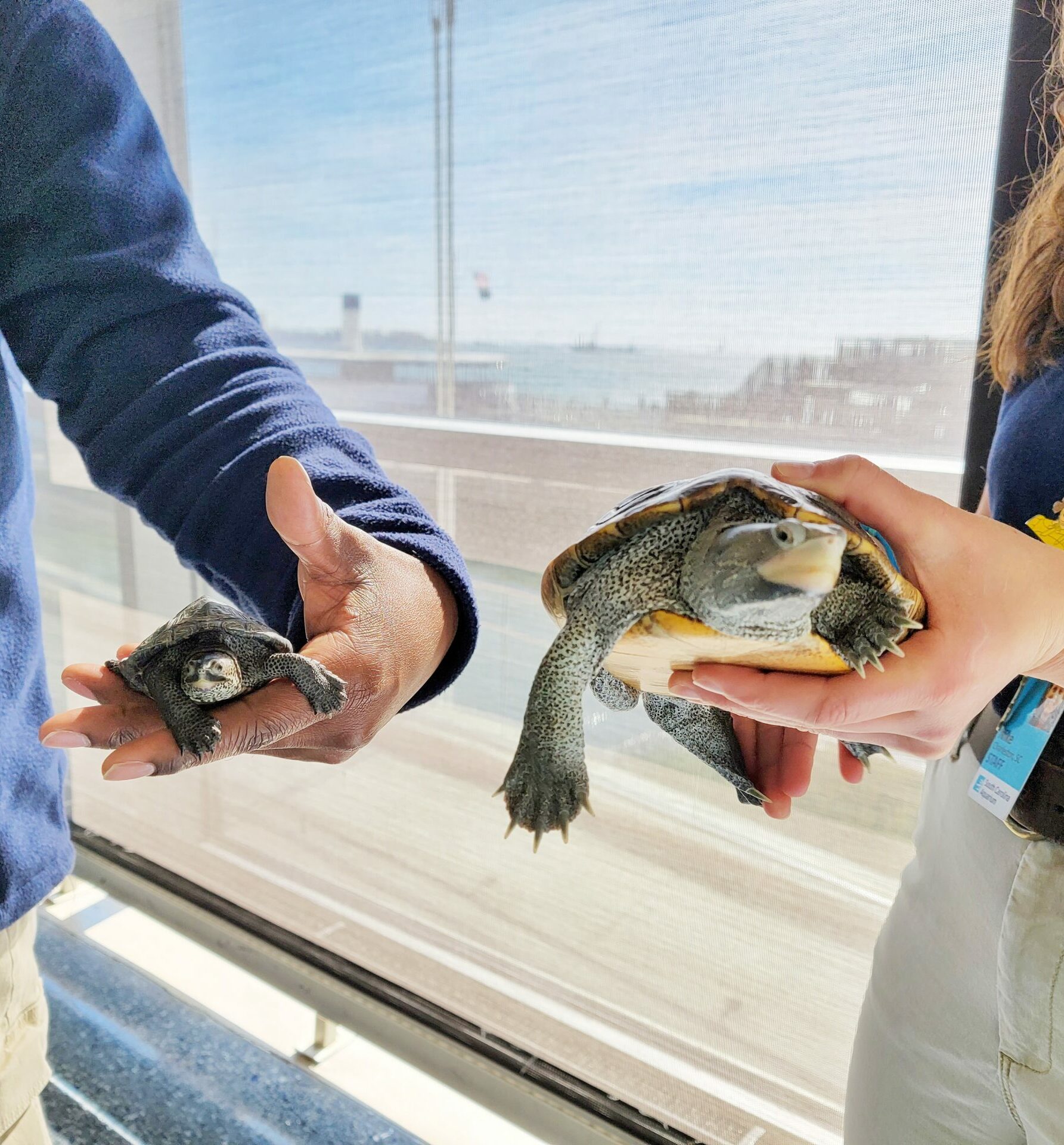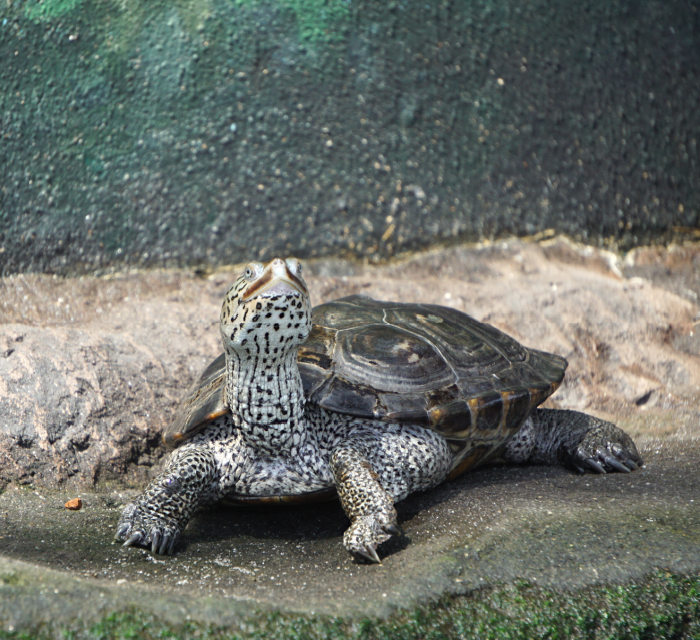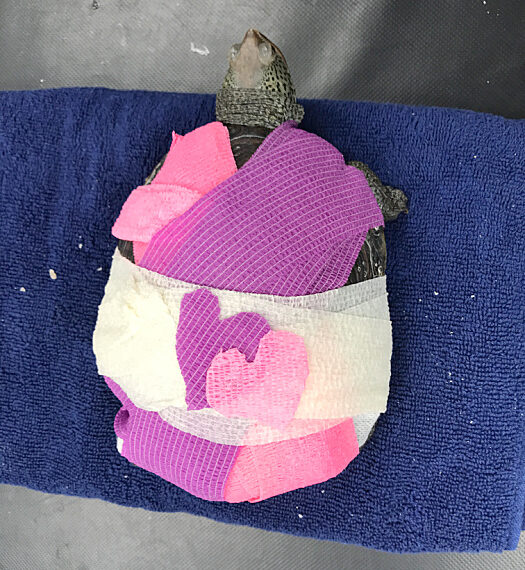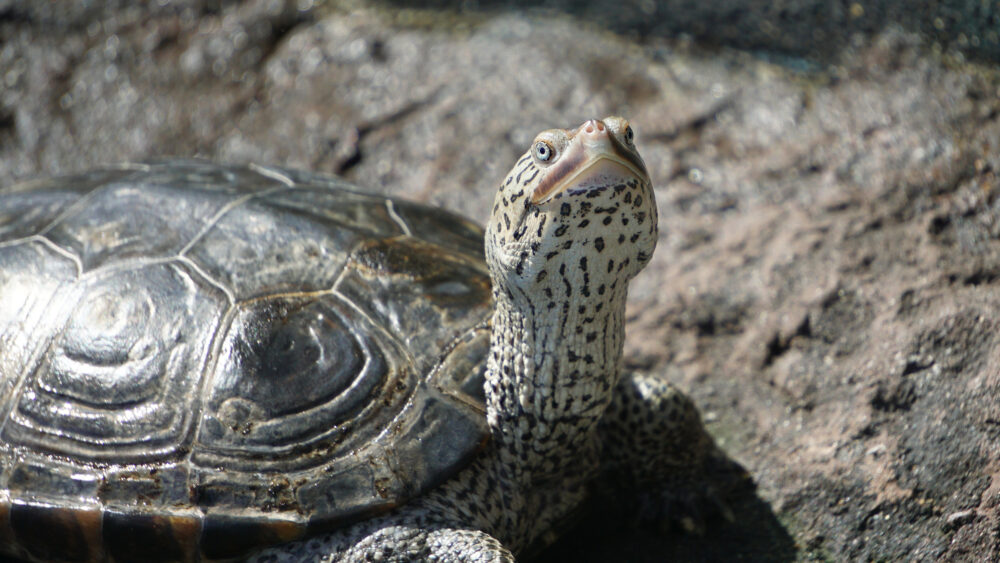What lives in brackish water, has seven subspecies and is the only species included in the genus Malaclemys? If you guessed the diamondback terrapin, you’re correct!
We love questions, and in a recent Ask an Expert submission, we were asked what characteristics separate a male from a female terrapin. Needless to say, we went on a fact-finding mission and consulted our resident experts for an answer!
It All Comes Down to Size
Whether it’s the shell, the head or the tail, size is the main differentiator when it comes to the sex of a diamondback terrapin. Adult females are nearly twice as large as males, with a carapace (shell) of up to 9 inches long compared to a male’s carapace at roughly 5.5 inches long. Terrapin shells range in color from light brown to gray or black with a yellow or greenish plastron (underside of the shell). A female’s head is also larger and wider than a male’s head.
On the flip side, male diamondback terrapins have a longer and wider tail when compared to females, with a cloacal vent (where waste exits the animal’s body) located outside the edge of the carapace.
 Huevos (left), male, and Clementine (right), female, are held by two educators on the Aquarium floor.
Huevos (left), male, and Clementine (right), female, are held by two educators on the Aquarium floor. One of our diamondback terrapins takes a rest in the Saltmarsh Aviary. See if you can spot a terrapin in our tanks next time you visit!
One of our diamondback terrapins takes a rest in the Saltmarsh Aviary. See if you can spot a terrapin in our tanks next time you visit!Subspecies of Terrapins
While we have multiple terrapins on exhibit, it’s almost impossible to know which exact subspecies each of them belongs to.
Diamondback terrapins inhabit the eastern coast of the United States, from the Massachusetts area all the way down and across to the coast of Texas. In these areas, diamondback terrapins are normally found in saltmarshes, tidal flats and sounds by barrier islands. For the Charleston area in particular, popular habitats of these animals include Kiawah Island, Folly Beach, Cape Romain and all throughout the Ashley River!
With diamondback terrapins, there are many variations between subspecies. If you see them in the wild, you may notice shell colors and skin markings differ slightly between each turtle. While terrapin skin is either dark gray or white, markings on the skin vary from dots of darker skin to small lines, or “bars.” They can sometimes have dark markings on their upper jaws as well, which gives the appearance of a mustache.
Here at the Aquarium, we have seven diamondback terrapins from multiple subspecies, with six being female and one confirmed male, Huevos. You might have seen Dory, Clementine and/or Huevos on the floor with some of our educators while Millie, Tesla, Heart and Star can be found out in the Saltmarsh Aviary throughout different times of the year. Interestingly enough, even though Millie and Tesla are from the same subspecies (which we know because they were collected in the same area), they have different markings. This is common in the same subspecies.
Some Tender Love and Terrapin Care
Our vet team has worked to rehabilitate multiple terrapins from the wild, including Christina Aguilera, Ladybug, Bon Jovi and Sweet Potato. (Yes, we love the names as much as you do!)
Christina Aguilera, an adult female, was admitted in May 2021 after she was hit by a car. She sustained multiple injuries, including a damaged carapace and a broken pelvis. Although our vet team was unable to manually repair Christina’s shell, they were able to remove the areas of dead shell to promote the natural healing process. We’re happy to say that Christina is healing well!
 Vet tech Whitney provided a little extra love and care for Christina when she added little gauze hearts to her bandages!
Vet tech Whitney provided a little extra love and care for Christina when she added little gauze hearts to her bandages!With the buildup of communities along the coastline, terrapin mortality rates have increased. In particular, car strikes have become a common threat to nesting female diamondback terrapins, just like Christina. Female terrapins often get struck by cars on their way to or from nesting. Thankfully, the Georgia Sea Turtle Center developed a program where researchers monitor causeways for female terrapins to assist them in crossing the roads. In this program, females that have been hit by cars are brought into the hospital for rehabilitation and, when necessary, eggs are extracted and incubated to later be released into the wild.
Ladybug, Bon Jovi and Sweet Potato were all admitted as hatchlings, each with different issues: Ladybug was found in an anthill covered in bug bites, Bon Jovi was discovered with a fractured plastron and Sweet Potato was actually spotted walking around, disoriented, outside our admission area. While Sweet Potato requires a little more time in our care, we are so pleased to report that Christina, Ladybug and Bon Jovi will be ready for release within the next few weeks!
 Two of our diamondback terrapin patients perch on a rock in their habitat during rehabilitation.
Two of our diamondback terrapin patients perch on a rock in their habitat during rehabilitation. Diamonds in the Rough
While diamondback terrapins are beloved by many today, they unfortunately used to be a popular food source. Throughout the specie’s history, they were hunted for turtle soup, which was considered a delicacy. Until the late 1920s, the entire species suffered huge losses in their population, only recovering once regulations were put into place.
Today, another present-day threat to diamondback terrapin populations is being caught in underwater crab traps. Mike Arendt, who works at the South Carolina Department of Natural Resources (SCDNR), has conducted research on excluder devices for crab traps, along with starting a program to report terrapin nesting and sightings.
Crab traps have such an impact on terrapins that the state of Maryland enacted laws specifically to protect these animals. These laws require that crab traps can only be kept underwater for a limited amount of time.
What You Can Do to Help
If you’re like us, you want to do everything you can to protect the amazing diamondback terrapin. Be sure to remember these few, small things you can do to help that will have a lasting impact on the species:
- Pay attention to wildlife in the roadways, and drive slowly in barrier island communities
- If you set a crab trap, make sure to check it regularly and don’t keep it underwater for long periods of time
- Use an excluder device in your crab trap
- If you see a diamondback terrapin in trouble, call SCDNR at 1 (800) 922-5431
Together, we can continue to make sure these diamondback terrapins shine bright like a diamond for years to come!
A special thank you to our experts, Joey Dornier, herpetologist, and Whitney Daniel, veterinary assistant, for their time and knowledge in creating this blog.
Do you have another question for our experts?
Published May 9, 2022


